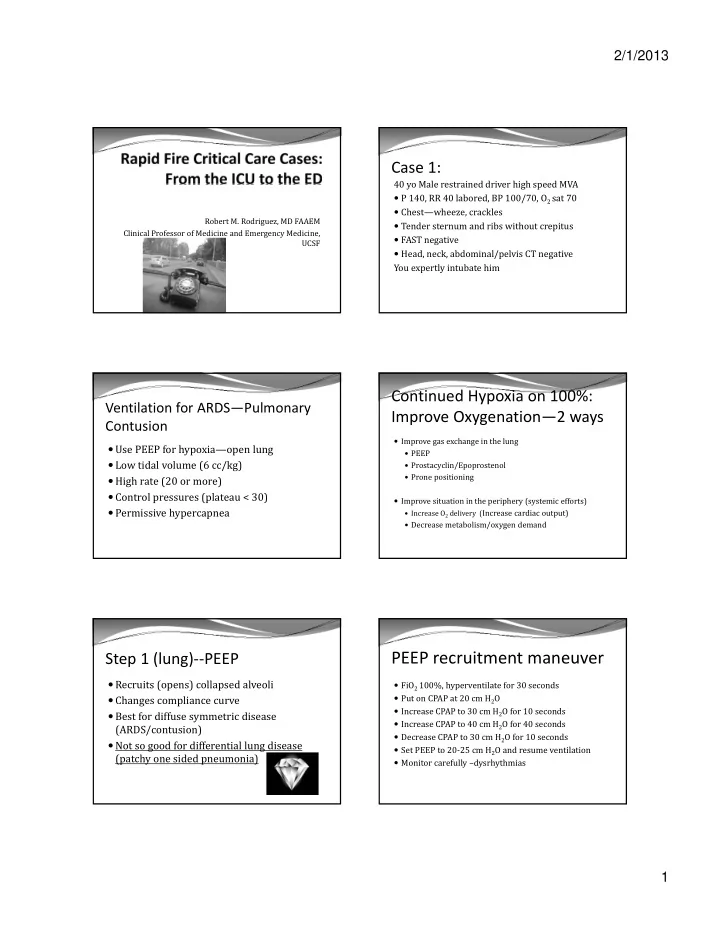

2/1/2013 Case 1: 40 yo Male restrained driver high speed MVA P 140, RR 40 labored, BP 100/70, O 2 sat 70 Chest—wheeze, crackles Robert M. Rodriguez, MD FAAEM Tender sternum and ribs without crepitus Clinical Professor of Medicine and Emergency Medicine, FAST negative UCSF Head, neck, abdominal/pelvis CT negative You expertly intubate him Continued Hypoxia on 100%: Ventilation for ARDS—Pulmonary Improve Oxygenation—2 ways Contusion Improve gas exchange in the lung Use PEEP for hypoxia—open lung PEEP Low tidal volume (6 cc/kg) Prostacyclin/Epoprostenol Prone positioning High rate (20 or more) Control pressures (plateau < 30) Improve situation in the periphery (systemic efforts) Permissive hypercapnea Increase O 2 delivery ( Increase cardiac output) Decrease metabolism/oxygen demand PEEP recruitment maneuver Step 1 (lung) ‐‐ PEEP Recruits (opens) collapsed alveoli FiO 2 100%, hyperventilate for 30 seconds Put on CPAP at 20 cm H 2 O Changes compliance curve Increase CPAP to 30 cm H 2 O for 10 seconds Best for diffuse symmetric disease Increase CPAP to 40 cm H 2 O for 40 seconds (ARDS/contusion) Decrease CPAP to 30 cm H 2 O for 10 seconds Not so good for differential lung disease Set PEEP to 20‐25 cm H 2 O and resume ventilation (patchy one sided pneumonia) Monitor carefully –dysrhythmias 1
2/1/2013 Decrease O 2 Consumption Step 2 (systemic): Optimize O 2 delivery Sedate‐‐Narcotics O 2 delivery = HR x SV x Hb x 1.34 x O 2 Paralyze? content Treat fever Transfuse to around HB 10 Optimize CO‐‐?Dobutamine? Follow mixed venous sat or lactate levels Step 3 ‐‐ Should you paralyze? Prostacyclin/epoprostenol Prostaglandin made by endothelial cells Concerns of prolonged weakness/paralysis—stuck on vent Pulmonary vasodilator NEJM RCT—double blind IV or inhaled Within 48 hours onset Virtually identical improvement pO 2 as NO Better 90 day survival Increase time of survival Not toxic/easier to use No increase weakness Lasts a few days Rescue Maneuvers: Prone positioning Improves atelectasis/heart compression of lung Improves V/Q Lasts days to week No improve mortality How? VERY CAREFULLY Rotational beds 2
2/1/2013 Case 2: ECMO 60 yo homeless male h/o EtOH C/O cough, Australia: H1N1 Flu—severe hypoxemic resp failure SOB, fever 48/68 = 71% survived to ICU discharge T 41.4, P 140, RR 40 labored, BP 100/70, Sat Review of 3 RCTs showed mortality benefit 70% on 100% NRB Odds Ratio mortality 0.78 Chest—ronchi on the left, right clear Recent large RCT showed significant benefit Make a plan Use for young Transfer early Bad unilateral pneumonia: Still use low tidal volume Hypoxia with Meta‐analyis of 20 studies—non ARDS Lower mortality unilateral lung disease Lower incidence of lung injury Lower incidence of nosocomial infections Avoid excessive PEEP USE GRAVITY‐‐‐GOOD LUNG DOWN! Fluids when hypoxic: Depends Later fluids (save the lung) on perfusion and timing Established ARDS—conservative fluid better Less time on vent Early fluid resuscitation (save the kidneys) Fewer ICU days Shock mortality correlates with renal failure No change in organ failure EGDT (early fluids rather than later) Only when no longer shock Don’t worry about volume overload WHEN IN SHOCK 3
2/1/2013 Case 3 BiPAP 60 yo F COPD Early rather than late C/O cough, SOB Better for COPD than asthma T 37, P 120, RR 30 labored, BP 100/70, Sat 80 Not so good for pneumonia Chest—wheeze, little air movement Awake, 2 word sentences ABG ‐‐ 7.20/70/70 How to make BiPAP work Case 4: 68 yo male VF arrest If no improvement post 20 min—won’t work ROSC with defibrillation Sit there with them Intubated Adjust straps Adjust I and E appropriately Vent settings? Sedatives can help Fentanyl KETAMINE Hyperoxia after Cardiac Arrest Kilgannon: Hyperoxia Adults post ‐ medical arrest Is too much oxygen bad post ‐ arrest? Over 6200 ICU patients Post ‐ arrest: oxidant stress leads to increased ABG in first 24 hours: cell death Hyperoxia: > 300 mm Hg: 18% Experimental models of hyperoxia Normoxia: < 300 mm Hg: 19% Worse oxidative stress Hypoxia: < 60 mm Hg: 63% Worse neuro outcomes 4
2/1/2013 Hyperoxia Bottom Line—FiO2 Hyperoxia—highest mortality (63%) No reason to give too much Hypoxia– (57%) Titrate down using pulse oxymetry to sat Normoxia– (45%) 95% Among survivors significantly lower independent function with hyperoxia (29% vs 38%) Odds ratio poor outcome 1.8 for hyperoxia Case 4 What type of fluids? 72 yo female with urosepsis Crystalloid Has history of CHF Hypotensive 76/48 Colloid does not work with possibly 1 HR 120 exception Bicarb not helpful even in extreme acidosis How to do Early Goal Directed Therapy without Catheters Lactate for EGDT Lactate is best perfusion marker in sepsis 3 rd goal in EGDT = ScvO2 > 70 Serial lactates equivalent to ScVO2 Traditional: catheter for serial ScvO2 Clearance of 10% lactate Send every 2 hours Catheters expensive and not widely available Most hospitals not prepared to do this with Peripheral venous is fine catheters 5
2/1/2013 Which crystalloid in sepsis Vasopressors—when? Sequential trial of ICU patients When do you start pressor? First 780 patients given mostly chloride rich (NS) Washout period, then 780 rescrictive chloride (Lactated Hartmann’s, plasmalyte) ANYTIME—don’t have to wait for “full tank” Chloride group had more AKI, more renal replacement therapy Quick burst: ephedrine or phenylephrine Bottom line—not definitive, but would switch to LR after 2 liters of NS Sepsis: Dopamine vs NE Sepsis pressors: Bottom line Prob should use NE Surviving sepsis campaign – both dopamine Look at HR and norepinephrine first line If low HR, might use dopamine Critical Care Med meta ‐ analysis: If high HR or any dysrhythmias—use NE 2800 patients Dopa greater mortality and more Add vasopressin if refractory shock (fixed dose) dysrhythmias No clear mortality benefit Allows lower NE dose Etomidate for sepsis Post ‐ intubation care intubation? 2 independent meta ‐ analyses Watch for hypotension—push fluids Both show with single dose etomidate No nasal tubes Increased adrenal insufficiency and HOB at 30 Increased mortality Oral gastric tube GI prophylaxis Bottom line: We have alternatives Give sedative, esp if used rocuronium (ketamine) so use them. 6
Recommend
More recommend